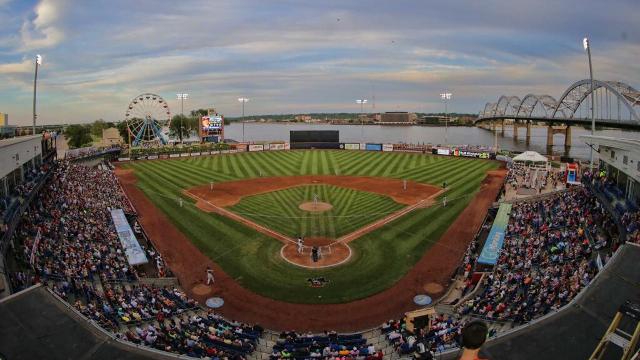This was already one of our favorite ballparks in the minors before it was dramatically revised in 2004. Basically, a classic 1930s-era was enhanced for the new millennium in dramatic fashion, with an iconic exterior retained and the best of modern facilities — club seating, suites, a wraparound concourse, integration with the waterfront, inserted.
Since then, every year has seen some sort of improvement, mostly in the form of cool amusements — including a Ferris wheel, providing dramatic views of the ballpark and downtown Davenport.
FAST FACTS
Year Opened: 1931; renovated 2004
Capacity: 5,500
Architect: Redesign, Populous
Dimensions: 343L, 400C, 318R
Suites: 20
Playing Surface: Grass
Website: riverbandits.com
Phone: 563/3-BANDIT
League: Midwest League
Level: Low Class A
Parent: Houston Astros
Parking: Free parking next to ballpark in paved and unpaved lots.
Address/Directions: 209 S. Gaines St., Davenport. The ballpark is located on the west side of downtown Davenport. River Drive runs along the south side of downtown Davenport and the Mississippi River, and the ballpark is at the corner of Gaines Street and River Drive.
The integration of the old with the new makes Modern Woodmen Park one of the nicest ballparks in the minors. Of course, it’s hard to go wrong with such a perfect location. The ballpark is perched on the shores of the Mississippi River and on the edge of downtown Davenport. Walk around the outfield concourse and you can watch river traffic slowly moving up- and downriver. (Front-office staff joked about holding a fishing contest from the center-field concourse when the Mississippi River last flooded; the flooding didn’t cause a halt in play.) Go to the third-base concourse and watch traffic go to and from Rock Island on a classic span bridge, the Centennial Bridge. If you have a kid, feel free to camp out in the play area down the right-field line, which gives you a great view of the river and the ballgame. From the first-base side you have a nice view of a surprisingly scenic Davenport skyline.
With the Mississippi River sitting directly behind the center and right field fence, it is a ballpark Mark Twain would have loved. He could have parked his raft and walked about 200 feet to a gate behind first base and taken in a game.
The 2004 renovation brought the ballpark to the modern era, adding 20 climate-controlled luxury suites, home and road clubhouses, batting cages, two picnic areas, two team stores and the Mediacom Sports Lounge. Really, the only thing left from the old ballpark is the impressive facade shown above. The ballpark reconstruction gave the city a chance to build a berm on the riverfront to prevent flooding that forced the old River Bandits out of the ballpark when it was flooded by the Mississippi. A new playing field complete with some spotty drainage in center field was also installed.
It is an intimate ballpark, to be sure. If you decide you want to get close to the action, you can. Modern Woodmen doesn’t have a lot of space in foul territory. There are bleachers down the left field line and a picnic area in right field, all with direct, close views of the field.
Over the years, team owner Dave Heller and the rest of the ownership group have upgraded the ballpark with a notable set of amusements, including the aforementioned Ferris wheel in center field, several smaller rides (including bumper cars and a carousel) and lots of kid-friendly bouncy houses.
CONCESSIONS
Food offerings at the ballpark have been overhauled in recent years, with more good prepared directly in front of the customers. That means grilled hot dogs, sausages and hamburgers on the concourse. It’s all good; also good is a selection of beers from local breweries.

HISTORY
The ballpark opened in 1931 as Municipal Stadium, home of the Class D Davenport Blue Sox of the Mississippi Valley League, hosting the likes of the Cedar Rapids Bunnies, Rock Island Islanders and the Moline Plowboys. At the time the Quad Cities was a major shipping, commercial and manufacturing hub in the Midwest, and the idea of three of the four Quad Cities hosting pro baseball wasn’t far-fetched.
But over time shipping moved out of the region and the manufacturing base — centered around the likes of John Deere and other farm-machinery vendors — eventually crumbled. Throughout it all, Davenport’s Municipal Stadium emerged as the center of pro baseball in the Quad Cities.
In 1971 the ballpark was renamed for longtime Davenport Times-Democrat sports editor John O’Donnell, a booster of baseball in the area. It did not go unchanged throughout the years. It was extensively renovated in 1989 to the tune of $4.5 million, adding office space to the second level of the grandstand and installing six rows of stadium-style seats along the field. In addition, there have been several additions down both lines.





